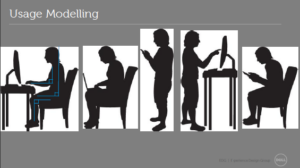The next speaker was Erin K Walline who is Director of Engineering – User Experience and Design at Dell. She said that you have to look at the whole experience if you want to understand the consumer. Dell has all of its design group in one organisation, covering surface design, industrial design, packaging design, user experience design and next generation design. There are parts of the team in nine locations around the world, including a big group in Taiwan.
There is a five year cycle to build really new products. If you don’t go through the full process over that kind of length of time the customer just gets a “collection of parts”. Dell started by offering whatever the customer wanted, but with mobile products and the latest generations, you need to deliver an emotional connection and a deeper experience. That changes what you offer.
The trends across all regions is towards younger, more mobile workforces and a blurring of work/life lines. Users also expect consistency and predictability between their mobile and desk devices. If users have to adopt different gesture libraries from different brands or products, they simply won’t adopt gesture at all, so standardisation is important.
What people think they want and what they really need may be different. To unify the “Dell experience”, there is a set of Dell “Core” areas where there is a commonality. However, Dell is also good at customising for, for example, ruggedised applications.
The XPS13 is a very thin bezel notebook (in an 11″ form factor) that Walline highlighted as having real display and design innovation. It took a lot of research and a partnership with Sharp to deliver the display and notebook.
Dell usage modelling shows workstation usage and posture is very varied
Dell recently did some work in Tier 1 to 6 cities in China to develop a better understanding of how people are arranging their workstations and workplaces to do what they want. There are big changes in how people are using their desks or their computers away from desks, compared to a traditional model.
Windows 8 is a very touch-centric OS, but a lot of devices were not really ready for this. Before Windows 8, touch on a clamshell notebook was a very niche market. Dell had to look in detail at how users used touch. For example, there were “wobble” and “tip” specifications for clamshell notebooks that have had to be modified to deal with touch.
Ergonomics have also changed as users moved from being simply sat at a desk to using devices in many different ways.

